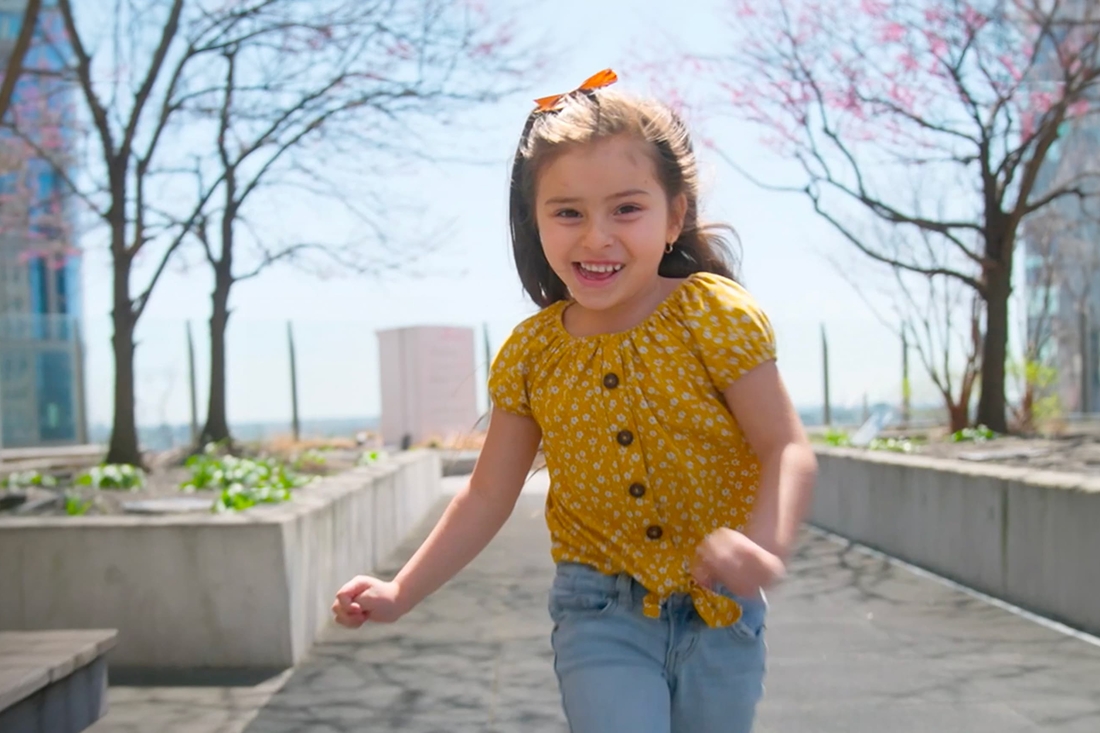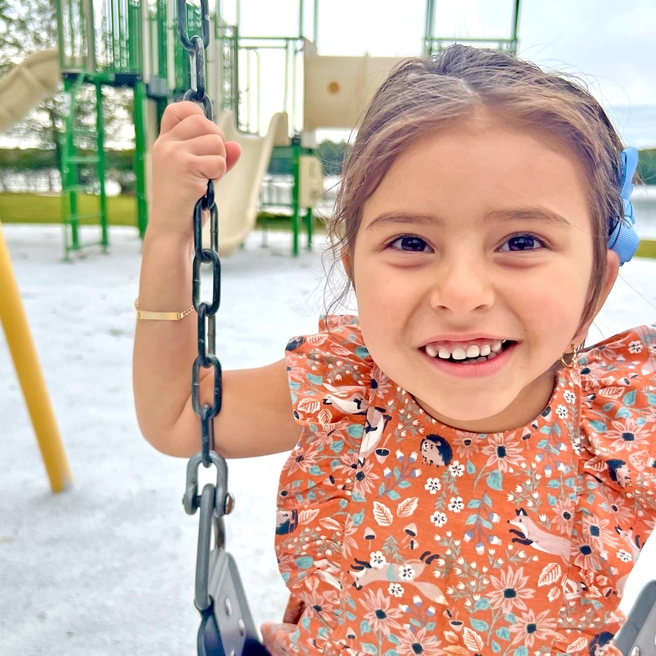Lilliana: One, two, three, four.
Angelina: How many pink things are there? Pink cans.
Lilliana: Five.
Angelina: Five? Good job. Okay. How many little children are there? The best thing about being a parent is watching your children grow. And being confident in themselves. And just being accepting of themselves. Because that's so important. I feel like the one thing that you have to do as a parent is teach your children to love themselves and to respect themselves and to show them that they matter and that no matter what decision or the way they look or whatever it is, that they're always going to be loved.
Lilliana: I need baby something to eat.
Angelina: And they're always going to be accepted.
Lilliana's a really outgoing girl. There was never a day that she was like, why am I different, or why don't I have an ear?
Lilliana does not have an ear canal or anything inside her ear, so she's completely deaf from that ear. You know, they always say God doesn't give you what you can't handle. And at first, having a son who was autistic, and we found out when he was three, and Lilliana's only 18 months apart from him, so it was really hard.
Like, the struggles were hard, and they still are hard. Every day we're like, you know, something new.
Jordan Swanson, MD, MSc: How are you? It's great to see you, Lilliana. As a young parent, it always impresses me when families are trying to piece together what happens when their child looks different than other children. And when I first met their family, they could see that she was largely missing her right ear. But they were also seeing other things, like the fact that her chin was pointed to that side.
Her teeth line, instead of being straight, was canted up on one side. She had less full cheekbones on one side. And for a lot of families, trying to figure out a unifying diagnosis is so important for them. All right, look up at the ceiling. Good job. So Lilliana has hemifacial microsomia. That means half of the face is smaller and didn't develop as fully as the other half of the face.
Because the other elements of the ear are all missing. So, this was the real big first step for Lilliana's treatment of reconstructing her ear. Because her jaw elements are smaller on the right hand side. The second aspect that we've not yet addressed, is her jaw development. She needs to grow a little bit more, but probably in a few years as her adult teeth are starting to come in, will be the right time to do a procedure to help realign her jaws and anticipate her future growth.
Our first clinic visit was really kind of an ah ha moment, I think for them of realizing, you know what, all these pieces that we're seeing actually come together. So I have an important question for you Lilliana. I'm going to start with you, and then I'm going to ask your dad, and then I'm going to ask your mom.
Tell me what we're going to do in your surgery. How are we going to reconstruct your ear?
Lilliana: Ear.
Jordan Swanson, MD, MSc: Any idea how? Okay, that's fair.
Leanne Magee, PhD: Plastic surgery, I think, is the perfect fit for pediatric psychology because we treat not just a condition, but a whole patient. And so kids live in families, in communities, in schools, in neighborhoods, and whatever medical condition they're managing and whatever surgery they're going through, they're doing that in a much broader system and context. So it puts kids at risk for additional social challenges, like curious questions and occasionally teasing and bullying from peers. So I think when we can integrate psychology services into surgical services, we help make sure that kids understand what their choices are, what to expect, and helping the whole family navigate their care.
Lilliana: I see you.
Leanne Magee, PhD: That's me. Yeah. I have to wear that around the hospital so everybody knows it's me.
Lilliana: Your ear.
Leanne Magee, PhD: I have two. Yeah. When I was born, I had two ears.
Angelina: It's okay to be different. It's okay just to be who you are. You don't have to change inside. If you feel comfortable changing your outside, you don't have to make everybody else happy.
You just have to make yourself happy.
Jordan Swanson, MD, MSc: Lillian's parents are awesome because they try to put her, even as a five year old, in the driver's seat. And try to ask her, hey, what do you think about this? And since I have a five year old right now, this is near and dear to my heart. With ear reconstruction, as we reconstruct that ear, to make that live, we have to get blood flow to it.
So one of the challenges for a surgery from my standpoint is, the blood supply of that flap has to work perfectly. So it's not about getting it 98 or 99 percent right, it has to be 100 percent right.
Angelina: Thank you Dr. Swanson.
Jordan Swanson, MD, MSc: You are so welcome. So I'll see you next Tuesday, bright and early, okay?
Angelina: So her upcoming surgery is next Tuesday.
They're going to be making Lilliana an ear. Now Lilliana will never be able to hear from that ear. The purpose of the surgery is to make Lilliana comfortable with herself so that she doesn't have to feel like she's any different than anybody else. And what we do now will affect her in our future and we wanted to make the right decision and after having many conversations with Dr. Swanson, we came to just the conclusion that this was this is what was best for Lilliana.
Sergio: I mean, she is a very strong girl and they can say like young age having that kind of surgery. Wow, that's amazing. I never see a child have so much, like strong personality in her.
Angelina: This is the beginning of her journey.
This is the beginning of her story. Who's that?
Jordan Swanson, MD, MSc: Well guys, good morning.
Angelina: Good morning.
Jordan Swanson, MD, MSc: How have you been in the last couple of weeks? Doing okay?
Angelina: Little nervous, but I think, I think that's just normal.
Jordan Swanson, MD, MSc: You know, we've talked a little bit in the past about her reconstructive journey. The thing about today is, Lilli's just gonna take a nap for a few hours while we do this.
And if she woke up at two in the morning, sounds like it's a good day to take a nap. So a little bit more about today. Surgery lasts about six hours or so. The nurses are gonna be giving you guys updates as we go. Letting you know that things are going okay, okay? I feel like you're giving me good luck.
Lilliana: High five.
Jordan Swanson, MD, MSc: High five!
Angelina: I love you, my girl.
Jordan Swanson, MD, MSc: You can see Lilliana's future shouldn't just be a reconstructed girl with two ears. Today was talking about Lilliana becoming a doctor. Lilliana the head of the dance troupe. These are the things we want the Lilliana's to be.
Well, we got a day ahead. You talk to a patient like that in pre op, and it sure makes you want to do everything you possibly can to do as well as possible, huh?
So today is a pretty special day because we're basically going to reconstruct an ear from nothing. How do we do that? Historically, people for many years and decades used parts of our body, like primarily the cartilage of the ribs, to reconstruct an ear. The challenges with that are a few, though.
Taking out ribs can be very consequential. It often takes three or four ribs worth of cartilage in order to reconstruct an ear. So, over the last 20 or 30 years, there's been a lot of efforts to how to do this better. We use an implant. Basically, porous polyethylene, which is like a medical grade plastic with pores and holes into it that the body tissue can grow into, covering it with a flap of the body's tissue that has its own blood supply and enables skin grafts to be placed over the top.
It's a meticulous surgery that requires everything to come together just right. Her external auditory canal will be right there, so let's make our measurement up from here.
So I think that's gonna be her aspective canal. We have a good 12 centimeters up to about 13. We should be very good there for our distance.
Angelina: This surgery is a really big part of Lilliana's life for her and in a physical way and emotional. So we're just hoping that Lilliana remains the same the little girl that she is, because I cannot ask for anything, you know, more than that.
Jordan Swanson, MD, MSc: Look, we're close to something there.
Cool. Alright, I think we see enough here. That's what we want to hear, the good blood flow. Okay, we got some good stuff. So, these are the blood vessels that go through this flap. Unfortunately, these usually start right in front of the ear nubbin right here. And she has some challenging anatomy. Hers starts from behind it, so it's just going to be a challenging dissection getting that out.
So the hardest thing for me about this surgery is that everything can go very smoothly during the operation. But, this is a surgery that can have a very high degree of fragility, even in the weeks and months as it's healing, and has the risk of having a devastating outcome even after the surgery. Good.
That's great. This branch right there, I think, lurking. Can we get a hook, please? Can I get a .5, please? It's a better match at the bottom. We're transplanting an implant into the head, and covering it with biological tissue. And if any of that biological tissue breaks down, and that implant were to get exposed, it's likely going to be infected and have to be removed.
So the ear construct comes from two pieces, and one piece we will use to be the base of the ear, and one piece we will use to be the helix of the ear, like that. Now she's five years old. She's going to grow a little bit more. Her left ear is 88 percent of the size of an adult female. With her hemifacial microcephaly, she's going to have slightly smaller ears.
So all that put together, maybe we want to go, you know, a couple millimeters bigger on this side, but probably not a lot bigger. I'm going to start thinning this in the meantime.
And this skin piece right here actually fits into a good spot. Yeah, that's going to be, that's going to be the contour like that. That's actually pretty good, guys.
So, this is the best, best part of the day in many ways when we finish the procedure and we can go tell the family that it went great. And I always feel a balance here because it's tough on the parents to be anxiously waiting for six hours as this goes on. We're done.
Angelina: Did she do good?
Jordan Swanson, MD, MSc: She did great.
Angelina: Yay!
Jordan Swanson, MD, MSc: She did really well.
Sergio: Thank you.
Jordan Swanson, MD, MSc: No problem. No problem. I can tell from your strong hug that it's been a long day for you guys. So, um,
Angelina: And for you as well.
Jordan Swanson, MD, MSc: You know, it's, it's a full day. But everything went really smoothly. Beginning to end, we did it really just as we'd anticipated.
Angelina: You know, this is not something that you want any child to go through. But I, we had to make that choice for Lilliana because we want to give her the best opportunities that she has and we want her to feel complete and whole and you were able to give her something that we could not. So we are forever grateful for that.
Jordan Swanson, MD, MSc: Part of what we all sign up for, everybody who is involved with the Children's Hospital is that we have to live the ups and downs of our patients and our families. I think what keeps us all feeling connected and balanced is patients like Lilliana, for whom getting through surgery takes a bit of cooperation, some anxiety, but as we get through, those results, totally reward the process we all commit to every day.
And I think when we see this for children, we see them get through it, that smile, that happiness, that wholeness is really what drives us all forward.
I'm looking for Lilliana, and I know there's one place to hide in this room, so she must be right there. She's not there?
Angelina: No, no Lilli here.
Jordan Swanson, MD, MSc: Alright, well she's left I guess. Oh my gosh, there she is. How are you? So I want to talk to you about your new ear. Can you look in the mirror and see your new ear? What do you think about that ear?
Lilliana: What is that red thing?
Jordan Swanson, MD, MSc: Yeah, it's still a little bit pink, right? It's still a pink and a little bit of it. But you know what? Every week it looks less and less pink. Every week it looks more and more like your own ear, doesn't it?
Angelina: It looks like this ear, right? Right.
Jordan Swanson, MD, MSc: Tell me about how you like your earrings.
Lilliana: Good.
Jordan Swanson, MD, MSc: Yeah, nice. Do you like that you and mommy can wear earrings together now?
Lilliana: Yeah. A lot of stuff, when when you go in the store, you have, um, earrings, and lip gloss, and make up.
Angelina: Your ears pierced?
Lilliana: Yeah, your ears pierced, and you, it, it hurt a little bit, but it not.
Jordan Swanson, MD, MSc: Any visit I have with Lilliana, at best I do about 10 percent of the talking. We know who's in charge here.
Angelina: There's always decisions to be made. Good decisions, bad decisions. But we wanted to give her that confidence. When she was younger for her to build and let me tell you, Lilliana is very confident because she's, she's a firecracker. She really, you know, at this age, they don't have any sense of like, this one's different.
That one's different. But as we grow, you know, those feelings occur and it's just a normal thing. So we didn't really want that to happen for her. It amazes me. Like how just such a situation that you think is so bad in life that can turn out to something so good.





